Easy-going Viareggio is a boisterous, sun-and-sand resort that is especially popular with Italian families. This friendly resort is more family-minded than most on this coast and is well-equipped with climbing frames and child-friendly cafes. The resort’s appeal lies in its endless stretch of golden sands, its air of faded elegance and its good-value seafood restaurants. Viareggio is the oldest of the coastal towns in Versilia. Its origins are Roman, and in the Middle Ages it was an important sea port. In the 19th century it reputedly built some of the best boats ever launched on the Tyrrhenian Sea, and the boatyards are still active. Its heyday was the 1920s and 1930s but only a handful of Art Deco and Art Nouveau waterfront buildings recall this era. Today, Viareggio is more famous for its February Carnival, proof that, unlike most resorts in Versilia, it doesn’t close down completely out of season.
Viareggio
-
-
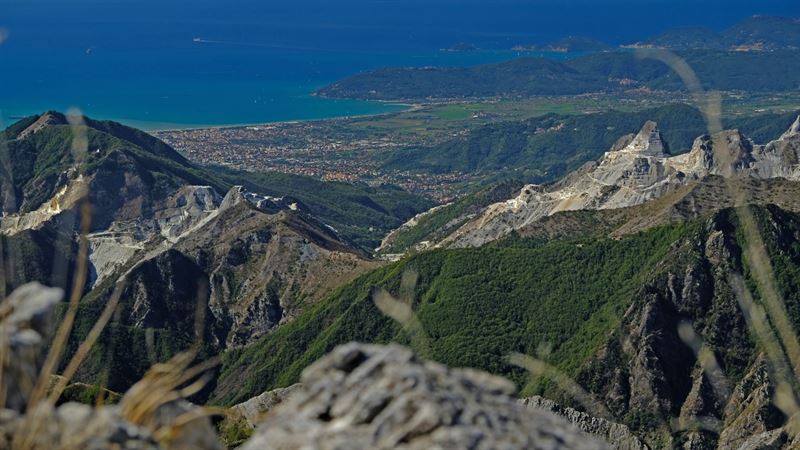
Top Things to Do
Viareggio is both a typical and atypical Italian beach resort. It’s typical in that beaches are well-run, family-friendly but rather regimented. It’s less typical in that there’s life beyond the beach. Nor is it just about being a summer resort - or being seen in the right places. Viareggio makes a good springboard for exploring Versilia, from cycle rides along the coast to drives that reveal the elemental hinterland around Massa and Carrara. For a sense of adventure, explore Carrara and the marble quarries in the Apuan Alps. This is wilderness Tuscany, a stark contrast to the coastal strip. For a cultural foray, turn away from the coast toward the closest art cities. Foremost among these are Pisa to the south, or Lucca, Pistoia or Florence to the east.
-

1. Viareggio Promenade
Commonly known as the “Passeggiata di Viareggio,” the seafront stroll is the best way to appreciate this faded but fun beach resort. Viareggio is big enough to be both a typical beach resort and a vibrant town with its own cultural life. Part of the resort’s charm lies in its difference: it is neither chic, over-priced, over-hyped Forte dei Marmi nor just another bland strip of bathing establishments, blighted by beachfront development. In short, Viareggio is a pleasing hotchpotch, offering a bit of everything, mostly at reasonable prices. A stroll along the seafront promenade sets the tone of the place, from the bustling beach-life to the cafes and retro architecture.
Viareggio’s heyday was in the 1920s and 1930s so an air of faded elegance survives in certain striking Art Nouveau and Art Deco buildings, mostly built as hotels or bathing establishments. The style, known as Liberty in Italian, features quirky Oriental ornamentation, decorative floral motifs, curved lines and exotic stylistic flourishes. On the Viale Margherita seafront, also known as Passeggiata Mar¬gherita, seek out the Art Nouveau Gran Caffè Margherita, which was Puccini’s favourite haunt. Its glittering Oriental domes are unmissable and the coffee is pretty good, too. If you fall for the Art Nouveau architecture, pick up the `Liberty Style’ guide from the tourist office, which suggests an intriguing itinerary. Remember, too, that beyond period charm, the resort is about seafront strolls, seafood dinners – and even ice cream out of season.
Address: Gran Caffè Margherita
Viale Margherita 30
Viareggio
Tel: 0584 581143
Web: www.facebook.com/MargheritaGranCaffe -
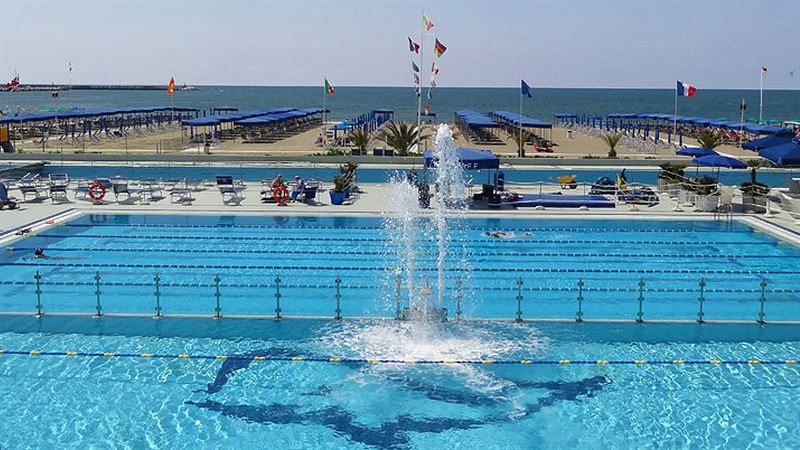
2. Beach-life, Viareggio-style
Viareggio, proud of its golden-sand beachfront and palm-lined promenade, remains the most popular big beach resort in Tuscany. Unlike Forte dei Marmi, it is not about posing where the latest Prada shades can best be appreciated. This is a fun sun-and-sand resort. The beachfront is mostly divided into stabilmenti, or bagni, bathing establishments where you can hire cabanas, sun-loungers and parasols but are still not quite true beach clubs. By the Gran Caffè Margherita (see above) is the entrance to two such bathing establishments, Bagno Amedeo and Bagno Balena, founded in 1873, among the earliest “bagni” in Italy. Bagno Balena boasts five pools, water sports, free WiFi, beach tennis, a proper spa, beach bar, sushi restaurant and kids’ club. Bagno Maurizio (via Giuseppe Barellai) is particularly friendly and good value for families.
Italian-resort-style, the sea is mostly reached by paying an en¬trance fee, although many “bagni” will let you in if you’re having a coffee or snack. For most non-Italians, the beaches have a regimented feel. Expect to lie on a sunbed among rows of others, on sand carefully raked and flat¬tened for your added comfort. On the other hand, paid access generally assures significant benefits, such as free WiFi, sun-loungers, showers, beach cabins, probably a bar or a restaurant. Beach games may well come with the territory and are even more entertaining to watch than to play. The water is also very clean, despite the crowds. In Viareggio, it’s often worth going in to bathing establishment in the afternoon and negotiating a discount on the sun-loungers. Versilia is now one of Italy’s surfing capitals. Viareggio’s Tito del Molo, in the northern part of the harbour, is particularly favoured by surfers.
Address: Bagno Balena (bathing establishment)
Passeggiata di Viareggio
Web: 0584 1660853 -
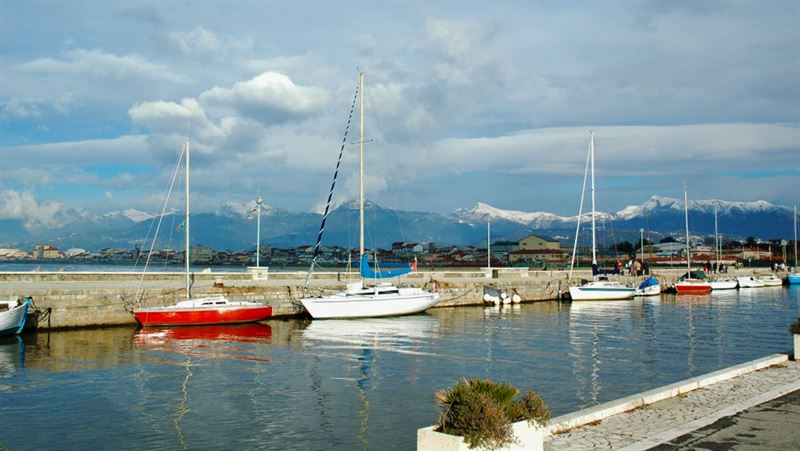
3. Dolphin-watching
Dolphins and whales live in the waters off Versilia and can be viewed on day trips from Viareggio in the viewing season. Between May and mid-September visitors can join research groups that set off towards La Spezia in search of Cetaceans. Although whales and manta rays are not ruled out, a big school of bottlenose dolphins represents the principal attraction. The dolphin-watching trips take place in the Italian part of the Pelagos Sanctuary, a Mediterranean marine park monitored by Italy, France and Monaco.
Several companies run whale-watching and dolphin-watching trips, including daily tours led by marine biologists on a Catamaran called Krill, leaving from Marina della Madonnina in Viareggio. Cetus, a non-profit association designed to safeguard whales and dolphins, has a base in Viareggio. There’s even a Cetus information centre and a permanent exhibition on Cetaceans in the Maritime Museum in Viareggio.
Museo della Marineria (Maritime Museum), Lungo Canale Est 32, Viareggio
T: 0584 944580 & 0584 371413
Cetus Centre: Cetacean catamaran day trips (maximum 8 people)
T: (+39) 335 6564469 & www.cetusresearch.eu
Tuscany Holiday: Dolphin and whale-watching day tours
T: 055 0351186 & www.tuscanyholidaymade.com -
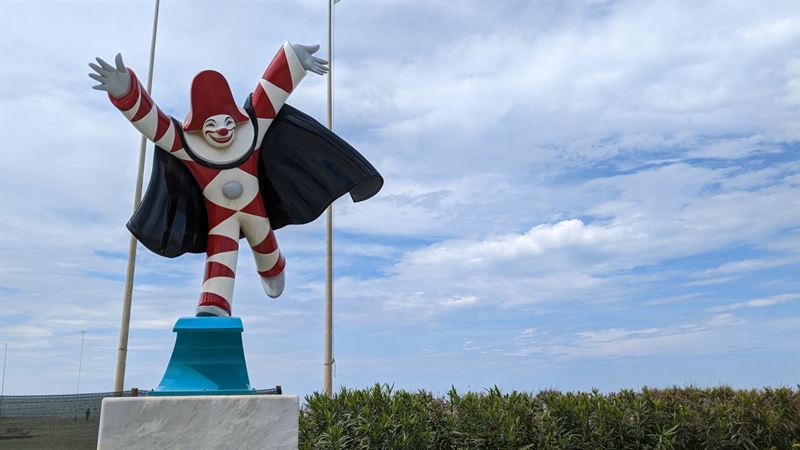
4.Viareggio Carnival Culture
Viareggio is a festive city with a sense of life throughout the year. It’s a resort with the mentality of a proper city and enjoys a confident cultural scene. This is particularly true of its Lenten Carnival, which, ever since 1874, has lit up the winter scene, usually in February. For creativity and craftsmanship, Viareggio Carnival is among the biggest and best in Italy. Expect traditional parades of gigantic papier-maché figures on colourful floats but also a huge sense of fun and subversiveness. For many Italians, Viareggio Carnival is the most flamboyant of all Italian carnivals, justly famous for its scathing political satire. Carefully-engineered floats are designed to reflect the chosen theme and are often spiced up with political sat¬ire, mocking the current leaders in Italy and abroad. The whole town joins in the festivities, with variety shows, masked balls, fire¬works, and even football matches. It turns into one long street party, with the seafront and backstreets lined with food stalls. The partying feels very inclusive, with visitors invited to join the revels.
The rest of the year craftspeople are hard at work building allegorical floats for the next edition, beavering away in huge hangers in the Carnival complex known as the Cittadella del Carnivale. This `Carnival City’ site also doubles as a Carnival Museum and entertainment centre, including for concerts and dance so you can visit outside Carnival time, too. It’s worth checking if there’s a papier-maché workshop on during your stay.
Address: La Cittadella del Carnivale
Piazza Giuseppe Mazzini 22
55049 Viareggio
Tel: 0584 58071
Web: https://viareggio.ilcarnevale.com/ -
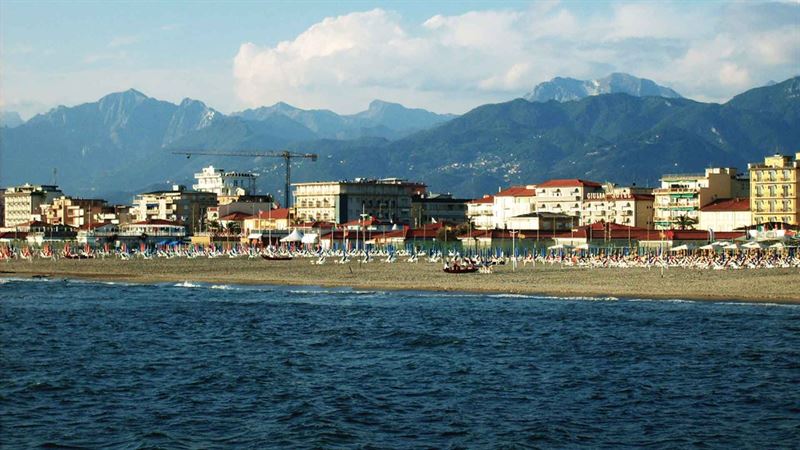
5. Fashionable Forte dei Marmi
Chic Forte dei Marmi is just 14km further north of Viareggio. For the smart set, summer here is highly ritualistic, with general agreement about which beach, beach club and cocktail bar is the most fashionable spot. Not that you have to follow the crowd. Essentially, it’s a place for playing with the rich. If you’re not, then just pretend. Treat it as an entertaining game. Guessing who’s pretending is part of the fun. You either get Forte dei Marmi or you don’t. This is the resort of choice for holidaying industrialists from Turin and fashion magnates from Milan. This is a resort once favoured by the great Gianni Agnelli and now patronised by the likes of Giorgio Armani, Andrea Bocelli and billionaires from the Balkans. The number of pricey sports cars seen cruising the streets in the early evening is directly proportional to the number of bulletproof vests required by the drivers and their bodyguards. Not that you need a fortune to enjoy the resort (though it helps). It’s enough to indulge in window-shopping rather than real shopping and to choose your pleasures with care. The shops and cafés around Piazza Marconi somehow still manage to retain something of a small town atmosphere, even if they do sell some of the most expensive items money can buy.
Cycle along the seafront promenade, preferably with a pooch in your basket and a floaty sundress. Walk along the pier, originally created to ship Michelangelo’s marble from the surrounding mountains. Wander the backstreets to sense the peace and quiet that artists and writers found here in the late 19th century. While window-shopping in the early evening, watch the millionaires picking out pointless pieces of designer jewellery. Save your real shopping for the Saturday market on Piazza Marconi. Indulge in some beach-lounging (see below). Swimming is optional, but preening is essential, preferably at a beach club. As the sun sets, make sure that you’re sitting at an outdoor café, in time to preen and pose over cocktails and nibbles. Don’t worry about missing the cultural attractions: they’re non-existent. After dinner, stroll along the seafront or find the closest gelateria for an ice cream. If you haven’t been invited to a beach club party, go to bed – and perform the same ritual for the rest of your stay. Seriously, you don’t need to follow the crowd, Italian-style. Read our full Forte dei Marmi guide to get its measure, including shopping and dining tips.
Twiga Beach Club, via Roma 2, Lungomare, 55042 Forte dei Marmi
T: 0584 21518 & https://www.twigafortedeimarmi.com/en/
Beach Club del Principe Forte dei Marmi, Hotel Principe, Viale Morin 67, 55042 Forte dei Marmi
T: 0584 784145 & www.principefortedeimarmi.com -
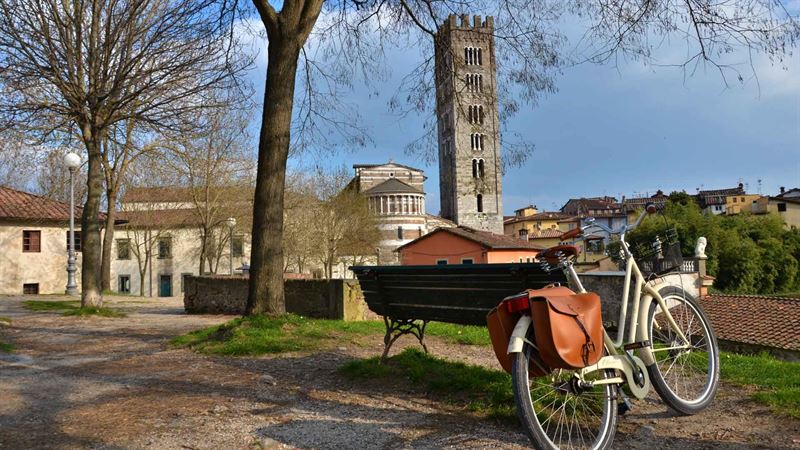
6. Cycling around Lucca - or strolling along the city ramparts
Lucca lies just 28 km east of Viareggio and makes a delightful change after you’ve tired of posing and preening at the beach. Lucca is a classic Tuscan city on a human scale, with just enough cultural attractions to beguile but not bewilder. In summer, outdoor concerts add to Lucca’s appeal, as do the discreet wine bars and cosy inns. To jaded urbanities, Lucca represents life as it should be led. Ringed by Renaissance walls, the city is made for leisure. The massive ramparts are now the place for jogging, flirting, gossiping and cycling – or several activities at once. It’s hard to believe that Lucca’s 500-year-old walls were built to keep enemies at bay. In 1817, the encircling ramparts were planted with a double row of plane trees, which shade the broad avenue ¬running along the top of the walls. This is now a popular playground, promenade, jogging trail and cycle route.
Lucca is full of lanes too narrow for cars, so join the locals on their bicycles for an intriguing city bike trail. Every now and again, you can take the sloped exit down into town and cycle around the key sites, locking the bike up to a gate when walking around a piazza. This, combined with Lucca’s reputation for culture and ¬intellectual pursuits, has earned the city the nickname of the `Cambridge of ¬Tuscany.’ British fashion designer Paul Smith, a keen cyclist, has a home in the hills and enthuses about cycling in Lucca: “I love cycling around the walls of Lucca; it's so relaxing because there are no cars.” There is something deliciously Continental about cycling around an historic walled city, through its pretty paved streets and piazzas – ideally with a delicious deli lunch tucked away in the basket. You can hire a bike with numerous companies, including Cici Rai close to Porta San Gervasio, the San Gervasio Gate. Daily bike hire costs about €15 per day. Cycling is also a healthy alternative to a day on the beach. For more on the main attractions and dining out, see our full guide to Lucca.
Cicli Rai (booking info), via d San Nicolao 66, Lucca
Tel: (+39) 348 8937119
Web: www.ciclirai.it -
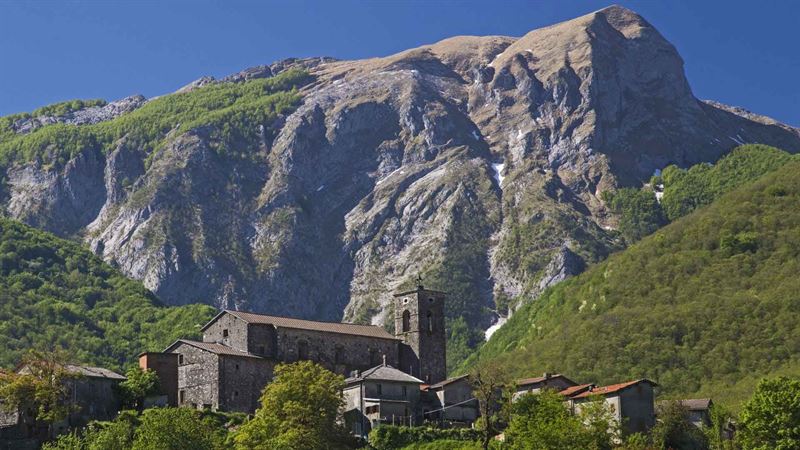
7. Carrara’s Marble Mountains
Tuscany’s northern corner is one of its wildest, strangest and least explored areas from the Versilia coast to a dramatic landscape of pine-covered mountains, craggy ravines. For a drive that explores Massa, Carrara and the elemental Apuan Alps, putting the marble mountains in their true context, see Apuan Alps Foray in our Forte dei Marmi guide. Instead, if you’d just like a sense of the surreal marble industry, then this is the tour for you. The northern coast is overshadowed by the marble industry. Even the beaches are dominated by the majestic marble peaks of the Apuan Alps glittering deceptively like snow in bright sunshine.
In the Apuan Alps awaits the marble town of Carrara, with several quarries offering guided tours and workshops. Carrara is 34km north of Viareggio so easily reached in around half an hour. The fine-grained pure white marble for which Carrara is renowned has been quarried here since Roman times. Italian medieval churches are decorated with marble from Carrara, and it has supplied artists from Michelangelo to Henry Moore with raw material. Formed from limestone, hardened by great pressure and heat, Carrara marble is still the world’s single largest and most important source of the stone. About 200 quarries are still functioning, while over a thousand have been worked out or abandoned. Since the Parco Apuane has been given national park status, opposition by environmentalists to the speed of extraction has heightened. However, the quarry owners continue to fight back in protection of their tough and fearless employees.
The marble quarries are scattered across three steep valleys, the Colonnata, Fantiscritti and Ravaccione. Here, the villages cling to the mountainside that has been sliced away like chunks of cheese. The Cava di Fantiscritti quarry makes for a good introduction to marble, as does the strange journey there. You drive through a series of stark tunnels that were used by marble-transporting trains until the 1960s, when trucks took over. En route there are extraordinary views down into the quarries, where precarious-looking staircases are strung across the sides, and massive trucks trundle across the marble surface far below. Once on the guided tour, prepare to be startled by the dank, foggy and slippery marble quarries that are often more like caverns. On display are strange marble blocks that look distinctly unlike the polished perfection of the final artwork. It’s a gritty scene, a world away from the cool, polished face of a marble Madonna in a Tuscan church. You will never look at marble in the same way again.
Address: Cava di Fantiscritti, via Miseglia Fantiscritti, Carrara: zarezerwuj z Marmotour (+39 339 7657470, www.marmotour.com) lub Cave di Marmo Tours (www.cavedimarmotours.com) -
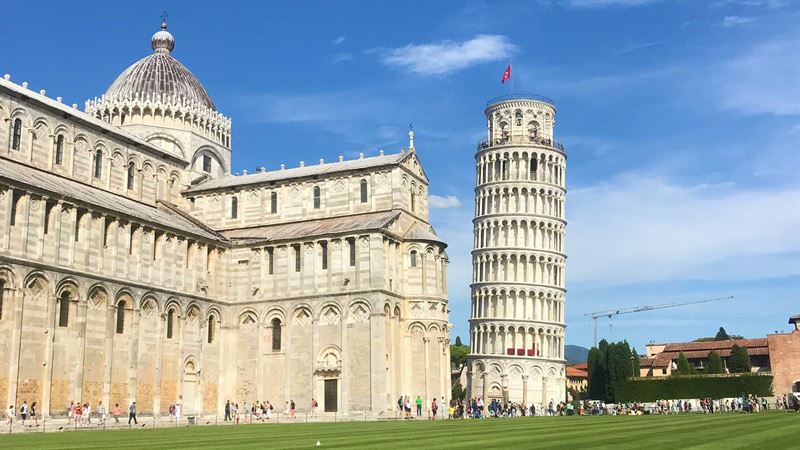
8. Pisa – more than the Leaning Tower
Pisa, 23 km south of Viareggio, makes for a perfect day trip. No city is as closely associated with one single monument as Pisa is with her Leaning Tower. It is a wondrous site but so are the Cathedral and Baptistery. Beyond this tourist-studded area, you will have much of Pisa to yourself. Unlike most Tuscan cities, Pisa's religious centre is not sealed inside the walls nor plonked in the old town but marooned on the northern edge of town. The star sights are clustered around the Campo dei Miracoli, a veritable Square of Miracles. Take in these celebrations of Pisan Romanesque and then explore the city itself. Or be radical: to avoid the photo-posing pandemonium, visit the town first and the Tower afterwards. Don’t restrict your visit to a selfie in front of the Leaning Tower. Spare a thought for the rest of Pisa, which is full of intriguing corners.
Begin with the Leaning Tower to salute one of Italy’s most famous monuments. Catch your first sight of the 12th-century Tower through the archway of the Porta Santa Maria, also known as the Porta Nuova. When the sun is shining, the whiteness daz¬zles; when raining, it glistens. The entire square, the Campo dei Miracoli, is studded with architectural treasures. Come to Pisa to take your fill of Pisan Romanesque, which was invented here. Pisa Cathedral, the Duomo, represents the glorious hybrid that is Pisan Romanesque. In form, it is austere Norman Romanesque but inspired by a Moorish Sicilian aesthetic and a Tuscan taste for marble. Yet the colourful geometry of the multi-coloured marble is essentially Tuscan. Also on the Campo dei Miracoli, a veritable Square of Miracles, stands Pisa Baptistry, the Battistero, the largest baptistery in Italy.
Clear your head with a walk along the riverbanks, known as the Lungarni. Also make time to stroll through the Borgo Stretto district for a sense of Pisan life. Pisa is not picturesque, and, beyond the `Field of miracles’, rarely tugs the heartstrings. But there is a warmer side to the city in the backstreets. The Borgo Stretto is a lively warren of alleyways and shopping streets between Piazza dei Cavallieri and the Arno riverbanks. Lined with cafes and shops, the arcaded Borgo Stretto opens out at Piazza Garibaldi and the Ponte di Mezzo bridge. It’s a perfect place for a wander in search of an ice cream, an afternoon coffee and cake, or a reasonably-priced meal. Call into the Pasticceria Federico Salza, an old-fashioned bar and pastry shop, set under the porticoes. It makes a tempting place for an afternoon coffee and cake or evening cocktails. For a full tour of Pisa, including a description of the Leaning Tower, plus restaurant and shopping tips, see our Pisa guide.
Torre Pendente (Leaning Tower), Piazza dei Miracoli, 56126 Pisa
T: 050 835011 & (online booking) www.opapisa.it
Pasticceria Federico Salza, Borgo Stretto 46, 56126 Pisa -
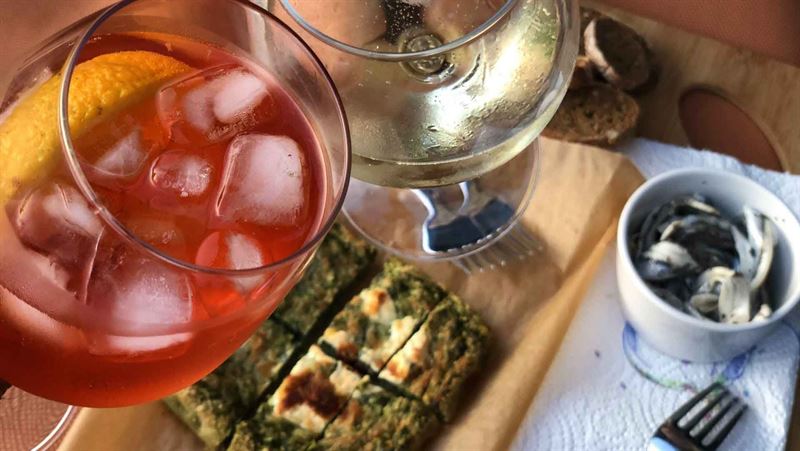
Eating & Drinking
In Viareggio seafood predominates, as on the Versilia coast in general. The resort specialises in cacciucco, a hearty fish soup, with other delights ranging from the catch of the day to grilled seafood, baked seabass, rock-octopus and stir-fried shrimps. The seafront restaurants are particularly appealing. Any stroll can end with sipping reviving drinks in the historic Gran Caffe Margherita on the seafront. The resort also boasts a number of stylish, creative and gourmet restaurants, including Michelin-starred affairs. Also see our beach club suggestions in the Forte dei Marmi beachlife section above.
-
Gran Caffe Ristorante Margherita
This legendary Art Nouveau café has moved with the times and serves versions of classic Tuscan dishes either in the historic dining room, or in the quiet garden behind. Beside the dining room is a trendy bookshop.
Address: Via Regina Margherita 30, 55049 Viareggio
Tel: 0584 581143
Web: www.facebook.com/MargheritaGranCaffe -
Bagno Balena
Founded in 1874, this bathing establishment has moved with the times and offers a pool bar - and a summery sushi beach restaurant which mixes Japanese dishes with more typical Italian seafood feasts.
Address: Passeggiata di Viareggio, 55049 Viareggio
Tel: 0584 1660853
Web: www.bagnobalena.it -
Il Piccolo Principe
This theatrical Michelin-starred restaurant finds favour with visitors and locals alike, thanks to its rooftop setting and the cuisine itself. The menu blends international gourmet dishes with more local favourites, with pricey tasting menus centred on meat or seafood. Specialities include roast scallops, crab-stuffed ravioli, beef tartare and roast pigeon.
Address: Piazza Giacomo Puccini, Grand Hotel Principe di Piemonte, 55049 Viareggio
Tel: 0584 401806
Web: www.ristoranteilpiccoloprincipe.it -
Caffè Principe
Set close to Piazza Marconi in neighbouring Forte dei Marmi, Caffè Principe is a perennially popular café made for people-watching. It sits on its laurels but remains a favoured spot for the smart set, at any time of day. The café can take you from breakfast to nightcaps. Come for a breakfast brioche, an Aperol Spritz or an affogato al caffè (a dessert made by dunking vanilla ice cream in espresso coffee) but prepare to pay well over the odds, even by local standards.
Address: Caffe Principe, via Carducci 2, 55042 Forte dei Marmi
Tel: 0584 89238
Web: www.principefortedeimarmi.com -
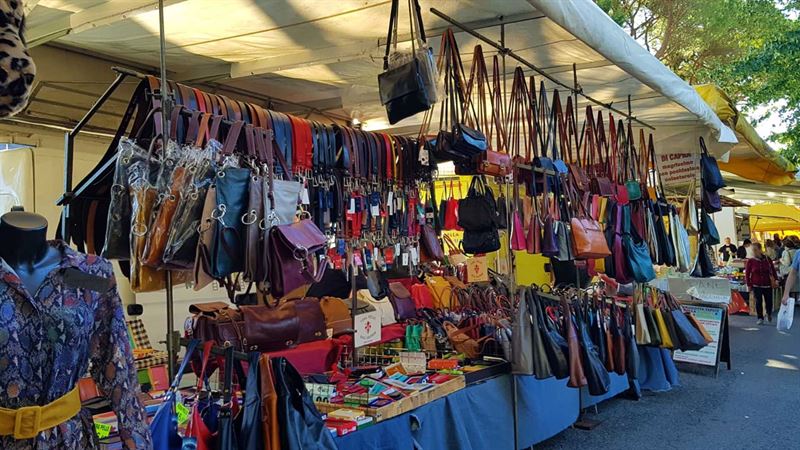
Shopping
Unlike Forte dei Marmi, Viareggio offers a broader range of everyday shopping, even if there’s plenty of designer shopping, too. For fun, browse Forte dei Marmi’s Wednesday market on Piazza Marconi for everything from mink coats to stylish bed-linen and swimwear, or top designer fashion to fakes. In summer there’s an additional Sunday market, held on the same square. If peckish while shopping, grab crunchy snacks of foccaccia or `pizza a taglio’ (pizza by the slice) from Da Valé, a popular bakery.
Address: Piazza Garibaldi 4, Forte dei Marmi
Tel: 0584 89361 -
Volponi
For one-off bags and hand-crafted shoes, head to Volponi in Forte dei Marmi.
Address: Via Carducci 4, Forte dei Marmi 55042
Tel: 0584 8271
Web: www.maurovolponi.it -
Profumeria Walchiria
This Art Nouveau, retro-style perfumery doesn’t seek to dazzle with designer scents but with niche fragrances. The knowledgeable proprietor willingly weaves spells around the perfumes, recounting the history of their creation and matching the right perfume to the right client.
Address: Piazza Massimo d’Azeglio 62, 55049 Viareggio
Tel: 0584 45069
Web: www.walkirialaprofumeria.com -
Parking
Viareggio provides easier parking options than do many Tuscan towns, except at peak periods. You might well find parking close to the main promenade but it tends to be paid parking (mostly running from 8am to 8pm). Alternatively, there are park-and-ride car parks (with free bus links) close to the sea and the main promenade.
Viareggio operates a popular park-and-ride scheme (known as parcheggi scambiatori/park-and-ride areas). These out-of-centre car parks allow anyone headed to the city centre to park and then take a free bus (or bike) onwards to the city centre. The buses run from early morning until around 9pm.
If you’re coming from the Via Aurelia, the nearest park-and-ride area is Largo Risorgimento. Terrazza della Repubblica is another park-and-ride scheme, and is handy if you’re coming from Lido di Camaiore or elsewhere on the Versilia coastline. Other car parks convenient for the centre include those on via Buonarroti and Stazione Vecchia. Both are linked by a free park-and-ride scheme to the centre.
For more on transport in Viareggio (and also Lucca Province in general), contact Mover: 0584 427021 and www.moverspa.it
Also see a parking map of Viareggio, which shows free car parks, cycle paths and bike-sharing spots:
https://tinyurl.com/5apz6xv2
-
Getting there & getting around
Getting there:
If you’re coming from A12 motorway, leave at the Viareggio-Camaiore exit. Make your way onto the Aurelia SS1 road, following signs to
a convenient car park, such as Largo Risorgimento.
By car:
From Viareggio it’s only a 14km drive (or cycle ride) to Forte dei Marmi. Pisa is around 23km south while Lucca is around 28km west and Florence is 110 km distant but a manageable drive for a day trip.
By train:
Viareggio station is set on the western edge of the city. It’s on the Florence-Lucca line and reasonably well-connected.
By bike:
At the main car parks, such as Largo Risorgimento, you can find free bikes, linked to a handy local bike-sharing scheme you can sign up to (via MO.VER, via Regia 4 - 55049 Viareggio, T: 0584-427021 & www.moverviareggio.it)
You can cycle to Forte dei Marmi, Marina di Pietrasanta and Lido di Camaiore. For details of cycling routes, check the Forte dei Marmi resort website and tourist office: (via Spinetti 14, 55042 Forte dei Marmi. T: 0584 28029 & www.comune.fortedeimarmi.lu.it)























